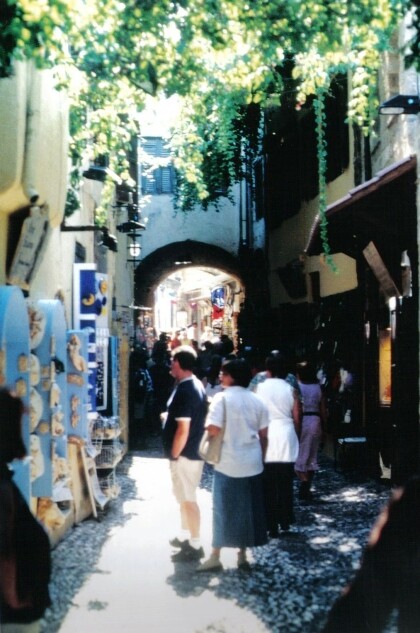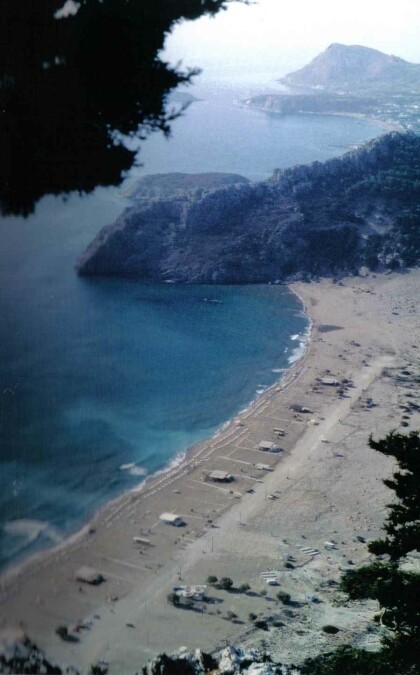GREECE - Landscape and Culture in Change by Klaus Metzger (ebook audio reader .txt) 📖

- Author: Klaus Metzger
Book online «GREECE - Landscape and Culture in Change by Klaus Metzger (ebook audio reader .txt) 📖». Author Klaus Metzger

Old Town
The Old Town of Rhodes is still surrounded by its 4 km of the medieval city wall, which is the land side bordered by a 2.5 km long moat. 1988 declared the entire old town to the cultural world heritage by UNESCO. We were ready to conquer the fortress again - but lacked JUTTA, the right clothes, because of temperatures above 25. C had not expected in October. As our hotel Delphinia Resort was located in Kolymbia, we used a straightforward manner the usual suburban bus to Rhodes town (distance about 25 km at a 3/4 hour drive) to a shopping spree in the old town. The next day we visited the medieval Rhodes.

Map
The Crusader fortress in Rhodes with the Grand Master's Palace and the Knight Street led us to a bygone age. The large balls of the Turkish conquerors were still visible in the moat. So we could remind ourselves, the force with which the all-powerful, Turkish armies are assailed against the desperate, small group of gallant defenders. The situation of the Hospitallers was hopeless. After posting the fortress all knights were in a ship - as already described - leave the island.

Fortification

Fortification
Cringe left us the idea that the Mandriki port then the privateers of St. John anchored on which Muslim prisoners of war were in chains as galley slaves. This does not have much to do with Christianity. But but you have to make it clear that the Turks Deten applying similar methods on their ships and captured inserting Christians as slaves. The raids were primarily merchantmen Ships for victims who were supplying the Hospitallers.

Mandriki Port
The Turkish rule lasted until May 1912. Italy occupied during the Tripolis war on May 4, 1912 Rhodes, and subsequently other parts of the Dodecanese. This meant that Rhodes was not affected by the Greco-Turkish Agreement of 1922 which provided for the forced resettlement of the Turks of Greece to Turkey and the Greeks of Asia Minor to Hellas: On Rhodes therefore, there is still a Turkish Muslim minority. So you will also find an interesting, Turkish cemetery, which refers to the former owners of Rhodes.

Turkish Graveyard
Since the Italian occupation (1912-1943) the harbor entrance is bordered by the statues of a stag and a doe, which are considered new landmark of Rhodes and the legend are the site where were the base of the Colossus of Rhodes in ancient times. One of the statues, however, was replaced by the Roman Capitoline Wulfe. The remote figure got a new place on a small base on the outskirts of the Mandraki harbor.

The Grand Master's Palace
The Grand Master's Palace was badly damaged by a munitions explosion in 1856. During the Italian rule (1912-1943) the reconstruction (until 1940) was a significant increase. This reconstruction is seen today as part of the politically determined monumental building program of fascism in Rhodes partly critical. Received original is still the entrance with its impressive towers. The newly built palace was intended as the residence of the Italian king and later as the seat of Benito Mussolini. Both did not get around to use it as such. Today it houses the Archaeological Museum of Rhodes. The way to the Grand Master's Palace led over the knights road that put us in the middle ages again. There the various country teams met among the knights in the relevant meeting rooms. A gate led to the Hospital, which have operated at the time the Hospitallers.
From the monastery Tsambika out, beautifully located on a hilltop and can be reached only after a sporting effort, you can get a breathtaking view over the Bay Tsambika enjoy (I did on Wednesday, 10 October 2001 bold). This bay is one of the most beautiful sandy beaches of the island of Rhodes. Since the whole area belongs to the church there are no hotels or large restaurants are allowed - what the bathing enjoyment certainly is not detrimental.

Tsambika Bay
The Tsambika Bay is a mile-long natural bay. It is located on the east coast of the island of Rhodes. Located between Kolymbia and Archangelos, it is about 30 kilometers from the island's capital, the city of Rhodes. From our hotel in Kolymbia so she was only a short distance (about 5 km). In the morning we used from the shuttle bus from Kolymbia, since we do not know the way. In the afternoon we wandered the hard way back (due to heat). For the walk back to the hotel took us 1.5 hours. On the way we visited a small chapel. The black-clad guardian allowed us to visit the church. For entry we bought several victims candles.

Icons in the chapel
According to legend, fishermen on the beach of the bay found an icon. This wondrous, as always repeating, fund motivated the creation and construction of the monastery Tsambika the north of the bay, followed by a steep slope.

View from the Mountaintop
The Tsambika church on the mountain peak altitude of 700 meters (with the great view of the bay Tsambika) it had done to me. Early in the morning (8 clock 30), on Wednesday, we were on our way. It was also at this time already considerably warm. On a plateau where there was a small church, we took a short rest. Then I marched on alone. At 10 clock I was on top of the mountain (particularly stressful were the last 300 steps to the Monastery input). I was rewarded with a magnificent view to Kolymbia and Tsambika Bay.

Lindos Bay
The place Lindos (55 km from Rhodes town and 30 km from Kolymbia) attractively located with the Acropolis is a listed building and can be seen on the back of a donkey. The small bay is explored firmly in the hands of the English, tolerate their travel companies no German competitors in Lindos. While there is no traffic in Lindos - still caravans are of tourists in the narrow streets, in which a shop next to the other strings, go. We arrived at Lindos again with the overland bus. On the way to the bus station we visited the Orthodox church of the Panagia in which not photographed and women had to wear a cape.

Kamiros
Kamiros (or Kameiros) was next to Ialyssos (or Ialissos) and Lindos one of the three cities of ancient Rhodes. From the city an extensive excavation field has remained on the west coast of the island, which is a clear example of an ancient (Hellenistic) City plant. 1000 BC Kamiros was founded "Ionian migration" of Dorian Greeks in the course of. In the city lived in the 6th century BC. Chr. Peisander the epic poet. After an earthquake, the city lost heavily after the founding of Rhodes Town in importance, built completely new and planned in the Hellenistic period was. .. 139 AD was again destroyed by an earthquake and apparently not rebuilt Kameiros; Ceramic finds, however, show that the place was finally abandoned in the 4th century.
The city was not attached. There are a Doric temple in antis double, a courtyard with fountain, houses with peristyle (rectangular courtyard), at the highest point a Hellenistic Stoa (doctrine) with original double row of columns and the remains of a Doric colonnade temple of Athena. The living quarters clay pipes are still visible for water supply.

Kamiros
The drive to Kamiros was a real adventure tour. In Rhodes town we wanted to change against 10 clock. We waited in vain, because the bus driver had decided to go on strike from 10 to 12 clock. There was then again a shift to 13 clock 30. This waiting time we used to dine in the Nea Agora (the "New Market" with numerous small shops). A fully air-conditioned bus took us 14 clock 30 free after Kamiros with. After an hour we went out and had to 17 clock time for the ancient complex. From the off cisterns that are above the settlement, we enjoyed the view and came into raptures.

Fish market in the Nea Agora
How Lindos is the seaside resort of Faliraki (10 km from Kolymbia Rhodes and towards town) in English hands. We found it there too hectic and too loud. And we were glad when we were back in our quiet resort Delphinia Resort in Kolymbia. Actually, we had to also go to Faliraki, just because of further DIA slights. I had 7 DIA films brought (which had been used) and required for scheduled recordings must have a DIA film. In Kolymbia he was not going to get. In the 3rd photo shop in Faliraki I got a super expensive Fuji film (3,200 drachmas = 18.- DM). So I managed a nice shot of a sunrise on the beach of Kolymbia. Now we calmed down - with many beautiful impressions - the flight home (Thursday, 18 October 2001) compete in Hanover.

Sunrise in Kolymbia
The considerations about our different holidays in Greece under the motto "Landscape and Culture" in transition. In this holiday we could see a significant change, because the landscape - a very densely populated - at least in the north. Striking were the many tourists who were treated partly very unfriendly by local staff. For me, the theme was "The Knights Hospitallers of Rhodes" of great interest and I collected relevant material for an informative presentation DIA. This took place on 17 January 2002 in Gustav Brandtsche- Foundation in Hanover. I had my friend, Prof. Dr. Dr. Heutger, invited. He was thrilled.
2005 - the impressive Palace on Knossos in CRETE
Hotel Beach Creta Royal
Write review my wife, Jutta Hartmann-Metzger, 2005, the Senior Magazine OLDIES Hannover under the title "CRETE - Island of ZEUS and EUROPE" written. The response was very positive. So I want to take their part unchanged. What can not be taken from her report, is the great disappointment with her digital camera. She had made great shots and when I was trying to read the images at home on the computer, the memory card was broken (what a disappointment!).
When we chose Crete as a holiday destination this year, we were looking forward to "the island" on which people are years older than in Germany. It wait a total of 300 days of sunshine a year to the guests of the island. Prima. Our starting point was Rethymnon and a hotel of the upper middle class (12





Comments (0)